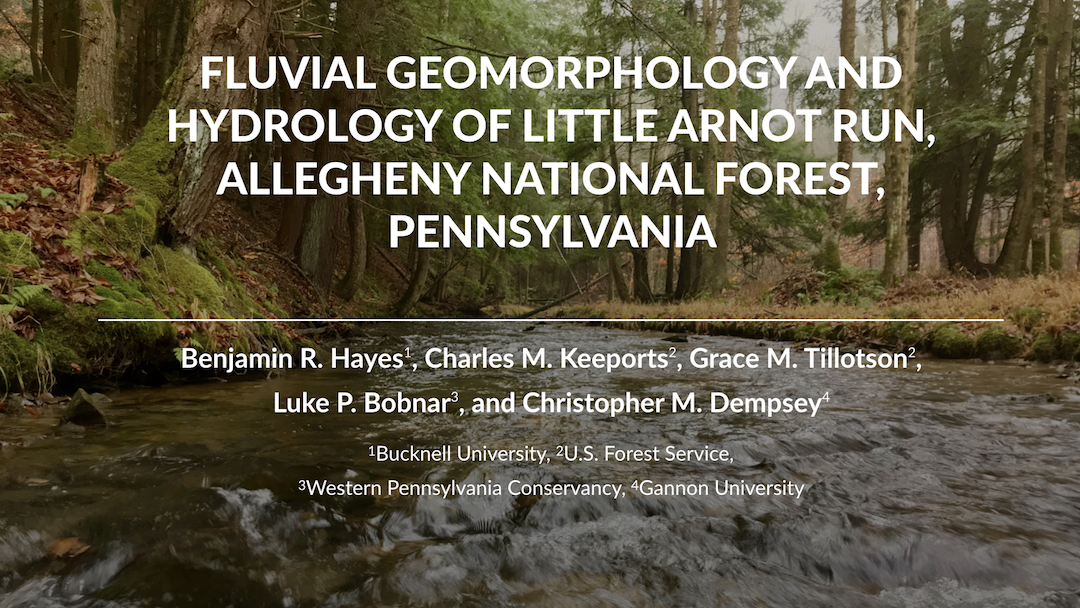Author:
Benjamin Hayes
Co-Authors:
Charles Keeports (U.S. Forest Service), Grace Tillotson (U.S. Forest Service), Luke Bobnar (Western Pennsylvania Conservancy), Christopher Dempsey (Gannon University)
Institution:
Bucknell University
Abstract
To help direct stream restoration activities scheduled to begin in 2021 in the Little Arnot Run (LAR) watershed of the Allegheny National Forest (ANF), we have been characterizing the factors controlling geomorphic processes operating with the watershed. Baseline hydroclimatic data are recorded every 15 minutes using a network of instruments, including a weather station, piezometers, stream gages, water quality sonde, and temperature sensors placed on the bed of the stream. A survey of stream and floodplain features along a 6.8 km length of the lower and middle reaches of the valley was conducted to characterize the stream at the reach- and channel-unit scale. The survey included inventory of large woody debris (LWD), the dimensions of bedforms and channel features such as pool/riffle/run/glide/cascades, width/depth measurements, pebble counts, and observations of channel bed and bank material, root strength, bank height and cohesiveness, evidence of historic alteration, etc. Synoptic measures of flow velocity, shear stress, and discharge are also being collected at selected locations in the channel.
At the reach scale, anthropogenic factors are the dominant influence on the channel morphology, which remains in a protracted phase of adjustment to alterations done during the 19th and 20th century. Relic logging berms, steam railroad grades, and oil infrastructure can be found throughout its lower and middle reaches. In many places the stream was dredged, straightened, and converted to a single-thread channel that is narrow and deep and remains disconnected from side channels up on the floodplain. Relic oil pipes and exploration pits are scattered throughout the floodplain, with broken pipes spanning the channel in several places; at least 12 oil well pads with J-pumps are active today. All these factors are under consideration as part of the restoration strategy.
Flows in the stream are relatively short lived in response to rainfall-runoff and snowmelt events, with a time of concentration of less than 6 hours and long recession curve, depending on the amount and duration of precipitation or snowmelt. Elevations of the stream and groundwater surface are recorded every 15 minutes in a network of piezometers and gage stations installed in the channel and adjacent valley alluvium. Following rainfall-runoff events, as stream levels rise, the groundwater table slopes away from the channel and down-valley, resulting in hydrostatic-driven exchange. This hyporheic exchange is driven by static hydraulic gradients which are determined by changes in water surface elevation in the channel, spatial heterogeneity in saturated hydraulic conductivity of the bed and bank material, and changes in the saturated cross-sectional area of floodplain alluvium through which hyporheic flow occurs. Falling-head tests conducted in three piezometers screened in the valley fill deposits indicate that the hydraulic conductivity (K) of the valley alluvium ranges from 4 x 10-3 m s-4 to 8 x 10-2 m s-1, suggesting hyporheic exchange rates could be very high. Limited exposures in well borings and stream banks suggest the valley fill material is laterally heterogeneous and longitudinally anisotropic, with highly permeable gravel/cobble layers likely controlling patterns of interfacial flux and flow paths. Additional work is underway to determine the rates and directions of hyporheic exchange, which greatly influences stream ecosystem processes and bio-geochemical cycles in Little Arnot Run and will be an important component of the restoration and management plan of this watershed and others throughout the Allegheny National Forest.
